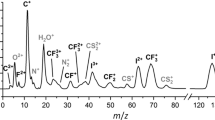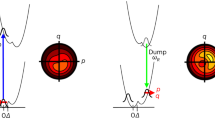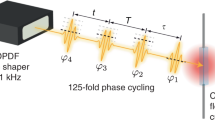Abstract
Tracing the transient atomic motions that lie at the heart of chemical reactions requires high-resolution multidimensional structural information on the timescale of molecular vibrations, which commonly range from 10 fs to 1 ps. For simple chemical systems, it has been possible to map out in considerable detail the reactive potential-energy surfaces describing atomic motions and resultant reaction dynamics1, but such studies remain challenging for complex chemical and biological transformations2. A case in point is the green fluorescent protein (GFP)3,4,5 from the jellyfish Aequorea victoria, which is a widely used gene expression marker owing to its efficient bioluminescence. This feature is known to arise from excited-state proton transfer (ESPT)6,7,8, yet the atomistic details of the process are still not fully understood. Here we show that femtosecond stimulated Raman spectroscopy9,10 provides sufficiently detailed and time-resolved vibrational spectra of the electronically excited chromophore of GFP to reveal skeletal motions involved in the proton transfer that produces the fluorescent form of the protein. In particular, we observe that the frequencies and intensities of two marker bands, the C–O and C = N stretching modes at opposite ends of the conjugated chromophore, oscillate out of phase with a period of 280 fs; we attribute these oscillations to impulsively excited low-frequency phenoxyl-ring motions, which optimize the geometry of the chromophore for ESPT. Our findings illustrate that femtosecond simulated Raman spectroscopy is a powerful approach to revealing the real-time nuclear dynamics that make up a multidimensional polyatomic reaction coordinate.
This is a preview of subscription content, access via your institution
Access options
Subscribe to this journal
Receive 51 print issues and online access
$199.00 per year
only $3.90 per issue
Buy this article
- Purchase on Springer Link
- Instant access to full article PDF
Prices may be subject to local taxes which are calculated during checkout




Similar content being viewed by others
References
Zewail, A. H. Femtochemistry: Ultrafast Dynamics of the Chemical Bond 217–326 (World Scientific, 1994)
Levine, B. G. & Martínez, T. J. Isomerization through conical intersections. Annu. Rev. Phys. Chem. 58, 613–634 (2007)
Shimomura, O., Johnson, F. H. & Saiga, Y. Extraction, purification and properties of aequorin, a bioluminescent protein from the luminous hydromedusan, Aequorea. J. Cell. Comp. Physiol. 59, 223–239 (1962)
Chalfie, M., Tu, Y., Euskirchen, G., Ward, W. W. & Prasher, D. C. Green fluorescent protein as a marker for gene expression. Science 263, 802–805 (1994)
Tsien, R. Y. The green fluorescent protein. Annu. Rev. Biochem. 67, 509–544 (1998)
Brejc, K. et al. Structural basis for dual excitation and photoisomerization of the Aequorea victoria green fluorescent protein. Proc. Natl Acad. Sci. USA 94, 2306–2311 (1997)
Chattoraj, M., King, B. A., Bublitz, G. U. & Boxer, S. G. Ultra-fast excited state dynamics in green fluorescent protein: multiple states and proton transfer. Proc. Natl Acad. Sci. USA 93, 8362–8367 (1996)
Stoner-Ma, D. et al. Proton relay reaction in green fluorescent protein (GFP): polarization-resolved ultrafast vibrational spectroscopy of isotopically edited GFP. J. Phys. Chem. B 110, 22009–22018 (2006)
Kukura, P., McCamant, D. W. & Mathies, R. A. Femtosecond stimulated Raman spectroscopy. Annu. Rev. Phys. Chem. 58, 461–488 (2007)
McCamant, D. W., Kukura, P., Yoon, S. & Mathies, R. A. Femtosecond broadband stimulated Raman spectroscopy: apparatus and methods. Rev. Sci. Instrum. 75, 4971–4980 (2004)
Ormo, M. et al. Crystal structure of the Aequorea victoria green fluorescent protein. Science 273, 1392–1395 (1996)
Yang, F., Moss, L. G. & Phillips, G. N. The molecular structure of green fluorescent protein. Nature Biotechnol. 14, 1246–1251 (1996)
Kasha, M. Proton-transfer spectroscopy. Perturbation of the tautomerization potential. J. Chem. Soc. Faraday Trans. II 82, 2379–2392 (1986)
Mandal, D., Tahara, T. & Meech, S. R. Excited-state dynamics in the green fluorescent protein chromophore. J. Phys. Chem. B 108, 1102–1108 (2004)
Weber, W., Helms, V., McCammon, J. A. & Langhoff, P. W. Shedding light on the dark and weakly fluorescent states of green fluorescent proteins. Proc. Natl Acad. Sci. USA 96, 6177–6182 (1999)
Kukura, P., McCamant, D. W., Yoon, S., Wandschneider, D. B. & Mathies, R. A. Structural observation of the primary isomerization in vision with femtosecond-stimulated Raman. Science 310, 1006–1009 (2005)
McCamant, D. W., Kukura, P. & Mathies, R. A. Femtosecond stimulated Raman study of excited-state evolution in bacteriorhodopsin. J. Phys. Chem. B 109, 10449–10457 (2005)
Dasgupta, J., Frontiera, R. R., Taylor, K. C., Lagarias, J. C. & Mathies, R. A. Ultrafast excited-state isomerization in phytochrome revealed by femtosecond stimulated Raman spectroscopy. Proc. Natl Acad. Sci. USA 106, 1784–1789 (2009)
Kennis, J. T. M. et al. Uncovering the hidden ground state of green fluorescent protein. Proc. Natl Acad. Sci. USA 101, 17988–17993 (2004)
Gaussian. 03 (Gaussian Inc., Wallingford, Connecticut, 2004)
Humphrey, W., Dalke, A. & Schulten, K. VMD – visual molecular dynamics. J. Mol. Graph. 14, 33–38 (1996)
Zhu, L., Sage, J. T. & Champion, P. M. Observation of coherent reaction dynamics in heme proteins. Science 266, 629–632 (1994)
Wang, Q., Schoenlein, R. W., Peteanu, L. A., Mathies, R. A. & Shank, C. V. Vibrationally coherent photochemistry in the femtosecond primary event of vision. Science 266, 422–424 (1994)
Kukura, P., Frontiera, R. & Mathies, R. A. Direct observation of anharmonic coupling in the time domain with femtosecond stimulated Raman scattering. Phys. Rev. Lett. 96, 238303 (2006)
Coe, J. D., Levine, B. G. & Martínez, T. J. Ab initio molecular dynamics of excited-state intramolecular proton transfer using multireference perturbation theory. J. Phys. Chem. A 111, 11302–11310 (2007)
Agmon, N. The Grotthuss mechanism. Chem. Phys. Lett. 244, 456–462 (1995)
Maddalo, S. L. & Zimmer, M. The role of the protein matrix in green fluorescent protein fluorescence. Photochem. Photobiol. 82, 367–372 (2006)
Cerullo, G. et al. Photosynthetic light harvesting by carotenoids: detection of an intermediate excited state. Science 298, 2395–2398 (2002)
Shim, S. & Mathies, R. A. Generation of narrow-bandwidth picosecond visible pulses from broadband femtosecond pulses for femtosecond stimulated Raman. Appl. Phys. Lett. 89, 121124 (2006)
Acknowledgements
Plasmids were provided by R. Wachter. We thank M. Marletta for the use of his laboratory facilities to express and purify GFP samples. We thank J. Dasgupta for discussions. This work was supported by the Mathies Royalty Fund.
Author Contributions C.F., R.R.F. and R.A.M. designed the research. C.F. and R.R.F. performed the spectroscopic measurements and DFT calculations. C.F. analysed the data and simulated the spectra. R.T. expressed and purified the protein samples. C.F. and R.A.M. wrote the paper. All authors discussed and edited the manuscript.
Author information
Authors and Affiliations
Corresponding author
Supplementary information
Supplementary Information
This file contains a Supplementary Discussion, Supplementary References and Supplementary Figures S1-S3 with Legends. (PDF 551 kb)
Rights and permissions
About this article
Cite this article
Fang, C., Frontiera, R., Tran, R. et al. Mapping GFP structure evolution during proton transfer with femtosecond Raman spectroscopy. Nature 462, 200–204 (2009). https://doi.org/10.1038/nature08527
Received:
Accepted:
Issue Date:
DOI: https://doi.org/10.1038/nature08527
This article is cited by
-
Optical control of ultrafast structural dynamics in a fluorescent protein
Nature Chemistry (2023)
-
Twisted intramolecular charge transfer of nitroaromatic push–pull chromophores
Scientific Reports (2022)
-
Improved spectral resolution of the femtosecond stimulated Raman spectroscopy achieved by the use of the 2nd-order diffraction method
Scientific Reports (2021)
-
Nonadiabatic quantum dynamics of the coherent excited state intramolecular proton transfer of 10-hydroxybenzo[h]quinoline
Photochemical & Photobiological Sciences (2021)
-
Experimental Protein Molecular Dynamics: Broadband Dielectric Spectroscopy coupled with nanoconfinement
Scientific Reports (2019)
Comments
By submitting a comment you agree to abide by our Terms and Community Guidelines. If you find something abusive or that does not comply with our terms or guidelines please flag it as inappropriate.



